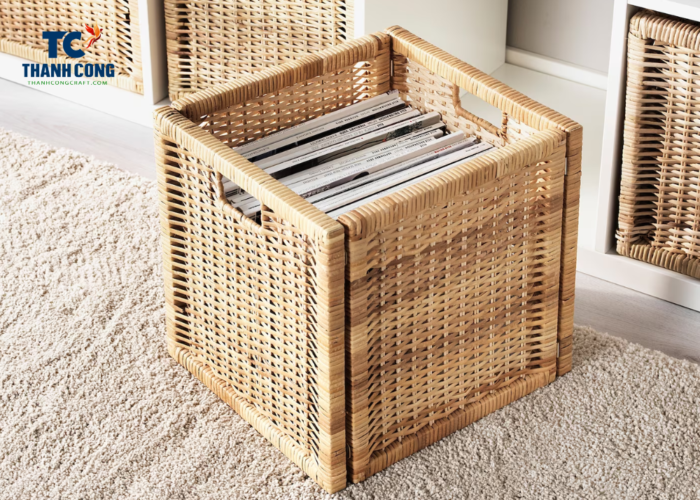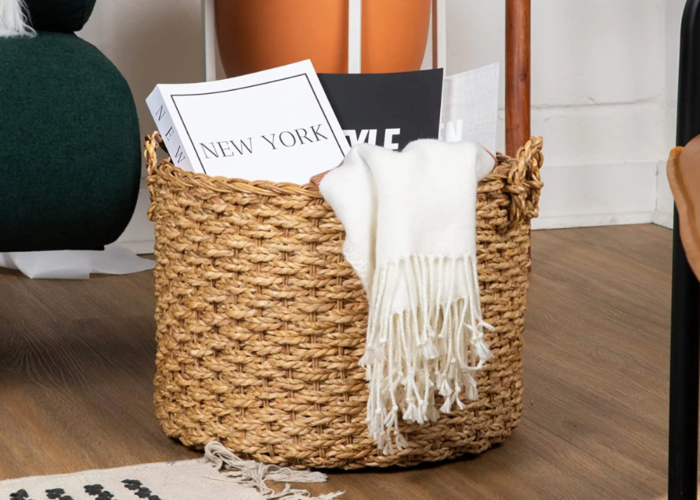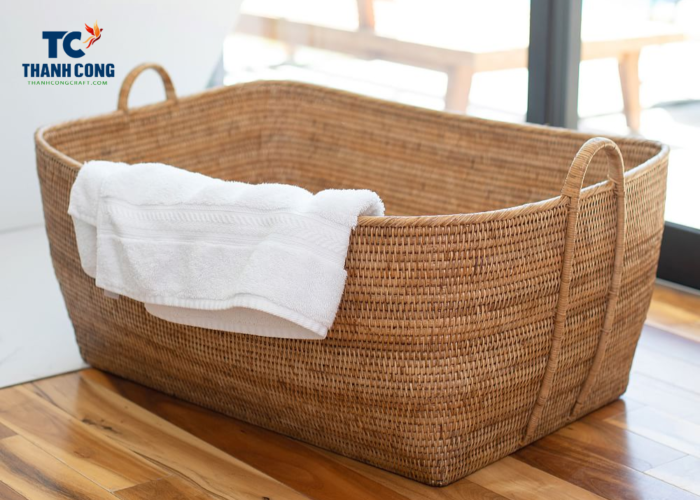Wicker baskets, with their timeless charm and practicality, often find a special place in our homes. Over time, however, wear and tear can take a toll on these delicate woven treasures. In this guide, we’ll explore the how to repair wicker basket, from simple fixes to more intricate restoration techniques, allowing them to grace your spaces for years to come.
Contents [hide]
1. Basket repair supplies
Before embarking on the journey of repairing a basket, gathering the right tools and materials is crucial. These supplies will enable you to address various issues, from minor damages to more complex restoration tasks.
Here’s a rundown of the essential basket repair supplies you’ll need to have on hand:
- Replacement Material: Depending on the type of basket you’re repairing, you’ll need matching wicker, cane, or reed material. This should closely match the existing weave in terms of color, thickness, and texture.
- Wicker or Cane Strips: These strips serve as the building blocks for weaving and repairing the damaged areas of the basket. Make sure to choose strips that are appropriate for the size and style of the basket.
- Reed Wicker: Reed splints are thin, flat pieces of reed used for weaving finer details and intricate patterns. They are especially useful for repairing more delicate baskets.
- Awl or Rattan Splitter: An awl or rattan splitter is used to separate and loosen the existing woven material, making it easier to weave in new strands.
- Scissors or Snips: These tools are essential for cutting and trimming wicker, cane, or reed material to the desired lengths.

- Adhesive or Glue (Optional): Depending on the severity of the damage, you might need adhesive or glue designed for wicker or natural materials to secure loose ends or strengthen weak areas.
- Clamps or Clothespins: These can hold the newly woven strands in place while the adhesive sets, providing additional support during the repair.
- Tweezers or Needle-Nose Pliers: These tools are helpful for weaving in reed splints or manipulating fine details in the weave.
By assembling these supplies prior to initiating your basket repair project, you will facilitate a smoother and more effective process of ‘how to fix a wicker basket.’ With the appropriate tools readily available, you’ll be well-prepared to rejuvenate the aesthetics and functionality of your treasured wicker baskets.
2. How to repair a wicker basket?
To repair a rattan basket, what you need to do is replace new rattan strands in the damaged area. Replace the damaged sections with new wicker strands or sticks. You can buy rattan strands at e-commerce websites such as Amazon, eBay, Walmart, or at local stores.
2.2.1. Replace Woven Strands
Repairing a wicker basket may require specific knowledge and skills in working with this type of material. Here are some basic steps to repair a wicker basket:
- Step 1: Prepare Tools and Materials
Depending on the damage, you may need tools such as wicker sticks, wicker reeds, wicker needles, specialized wicker glue, and matching wicker weaves for the basket.

- Step 2: Replace and Repair Broken Wicker Strands
If there are broken strands, carefully trim away the damaged sections. Then, use new wicker strands or wicker sticks to replace the old ones. Weave them into place and ensure that knots and weaves are securely tightened.
- Step 4: Repair Weak Joints
Inspect the joints and weak points on the basket, such as corners and connecting points. If necessary, reinforce these areas with wicker sticks or strands to ensure the stability of the basket.
Please note that repairing a wicker basket can be quite intricate and requires knowledge of working with wicker material. If you’re not confident or experienced, seek help from a professional craftsman for guidance and repair.
2.2.2. How to repair a wicker basket handle?
Repairing a wicker basket handle can vary depending on the type of damage and the specific design of the handle. Here’s a general guideline for repairing a wicker basket handle:
- Examine the wicker basket handle to determine the nature and extent of the damage. Common issues include broken wicker strands, loose weaves, or detached sections.
- Depending on the damage, you might need tools such as wicker sticks, wicker reeds, wicker needles, strong glue suitable for wicker, and matching wicker weaves.
- If the handle has broken wicker strands, carefully remove any damaged sections. Replace them with new wicker strands or sticks. Use a wicker needle to weave the new strands into the existing pattern, ensuring they are securely fastened.

- To repair a wicker basket with the handle have come apart, reattach them using strong wicker glue. Apply the glue to the broken sections and press them together firmly. Then, allow the glue to dry.
- Inspect the handle for any weak points or areas prone to future damage. Reinforce these areas by weaving additional wicker strands or sticks around them to add strength and stability.
- If the weave of the handle is loose or uneven, carefully weave additional wicker strands through the existing pattern to restore its shape. This might involve undoing part of the weave and reweaving it.
- After making the necessary repairs, allow the handle to settle and the glue to fully dry, if applicable. This ensures that the handle is sturdy and secure.
- Once the repair is complete, clean the handle gently and avoid placing excessive weight or strain on it. Store the basket in a dry, cool place to maintain the handle’s integrity.
2.2.3. How to repair wicker laundry basket?
Wicker laundry baskets are both durable and visually appealing, but they can become damaged over time. If your wicker basket’s handle is broken, the weave has split, or there’s a moldy area, you can repair it with basic tools and materials.
Here’s how to restore your wicker laundry basket:
- Fixing a Broken Handle: To repair a broken handle, gather a thick dowel, a saw, a drill, and screws. Remove the cracked or broken section of the handle, and eliminate any excess material from the channel. Cut a dowel piece that snugly fits the channel, extending about an inch beyond the basket at both ends. Drill pilot holes and attach the dowel with screws on each end. You can also paint or stain the dowel to match the basket’s color.
- Repairing a Split Weave: For a split weave, you’ll need wood glue and a clamp. Apply glue to the broken ends of the weave, and press them together. Utilize a clamp to hold them in place until the glue sets. Trim away any surplus glue using a knife or scissors.
- Dealing with Mold: If you’re facing a moldy spot, gather bleach, water, cotton swabs, and a toothbrush. Create a mixture of bleach and water in a 1:1 ratio within a small bowl. Dip a cotton swab in the solution and apply it to the affected area. Use a toothbrush to scrub away stubborn mold. Rinse the area with plain water and let the basket air-dry thoroughly.
By following these instructions, you can restore your wicker laundry basket to its original state and continue using it for many more years.
3. Frequently Asked Questions
3.1. Why does wicker crack?
Wicker can crack due to various factors, such as exposure to moisture, sunlight, temperature changes, or physical stress. Cracking can affect the appearance and durability of wicker products, and may also cause injuries if the cracks are sharp or jagged.
3.2. Can a wicker basket be reshaped?
Yes, a wicker basket can be reshaped to a certain extent, but the degree to which it can be reshaped depends on the flexibility and condition of the wicker material, as well as the complexity of the basket’s design.
3.3. How do I keep my wicker basket from breaking?
To keep my wicker basket from breaking, avoid overloading your basket with heavy or sharp objects that can strain or damage the weave.
- Keep your basket away from direct sunlight, moisture, and extreme temperatures that can cause the wicker to dry out, crack, or warp.
- Dust your basket regularly with a soft cloth or a vacuum cleaner with a brush attachment to remove dirt and debris that can accumulate in the crevices.
- If your basket gets wet, dry it as soon as possible with a towel or a hair dryer on low heat. Do not leave it in a damp place or expose it to steam.
- If your basket gets loose or frayed, trim the excess strands with scissors or glue them back with a hot glue gun. Do not pull or tug on the loose ends as this can unravel the weave.
3.4. What is the best glue for wicker furniture repair?
The best glue for wicker furniture repair is Titebond Original Wood Glue. This glue is an excellent option for wicker repair due to its water-resistant properties and clear drying.
In addition, you can refer to some other types of glue such as Epoxy Resin, Cyanoacrylate (Super Glue), Polyurethane Glue, Marine-Grade Adhesive,…
Above is the answer to the question: How To Repair Wicker Basket. If you have any further questions, please don’t hesitate to contact Thanhcongcraft via email at info@thanhcongcraft.com or message us at WhatsApp: +84967485411. Hope to serve you soon! Best regard!


